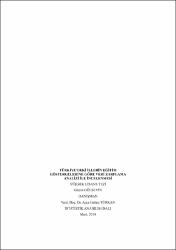| dc.contributor.advisor | Türkan, Ayça Hatice | |
| dc.contributor.author | Gülsevin, Gizem | |
| dc.date.accessioned | 2019-05-23T06:08:18Z | |
| dc.date.available | 2019-05-23T06:08:18Z | |
| dc.date.issued | 2014 | |
| dc.identifier.uri | http://hdl.handle.net/11630/6085 | |
| dc.description | Determining the development levels of countries, regions or provinces is one of the most important issues. In the development of contries, the provinces constitute the basic units. Analyzing the development levels of provinces, there is a strong relationship between economical and social development levels and education level of community living there. Education is one of the factors that provides development of individual and community and contributes to socio-economic and cultural development of countries. Therefore, in this study, the efficiencies of provinces in Turkey were compared in terms of education which is an indicator of socio-cultural term using data envelopment analysis (DEA). In this study, 81 provinces were determined as Decision Making Units (DMU)s. Data analysis was made standardizing data to be more consistent statistically and eliminating the effects of magnitudes such population size and acreage. In this study, output-oriented CCR model is used to measure relative efficiency, and output-oriented BCC model was used to measure technical efficiency and scale efficiency. Furthermore, the efficiency scores were determined via EMS. According to the results of the output-oriented CCR model 40 provinces are found to be efficient, and 49 provinces are found to be efficient for output-oriented BCC model. Also, potential improvements rates for inefficient provinces are determined. | en_US |
| dc.description.abstract | Ülke, bölge ve illerin gelişmişlik düzeylerini belirlemek önemli konulardan biridir. Ülkelerin gelişmesinde temel birimleri iller oluşturmaktadır. İllerin gelişmişlik düzeyleri incelendiğinde, ekonomik ve sosyal gelişmişlik düzeyleri ile o ilde yaşayan toplumun eğitim seviyesi arasında güçlü bir ilişki bulunmaktadır. Eğitim, bireyin ve toplumun gelişmesini sağlayan ve ülkelerin sosyoekonomik ve kültürel kalkınmasına katkı sağlayan unsurların başında gelmektedir. Bu nedenle bu çalışmada, Türkiye’deki illerin etkinlikleri, sosyokültürel bir gösterge olan eğitim açısından Veri Zarflama Analizi (VZA) yöntemi kullanılarak karşılaştırılmıştır. Çalışmada 81 il Karar Verme Birimi (KVB) olarak belirlenmiştir. Çalışmada kullanılan verilerin istatistiksel açıdan daha tutarlı hale getirilmesi ve illerin nüfus ve yüzölçümleri gibi büyüklüklerinin etkisini ortadan kaldırmak için mevcut verileri standartlaştırarak analiz yapılmıştır. Çalışmada göreli etkinliği ölçmek için çıktı yönlü CCR (Charnes, Cooper ve Rhodes) ve teknik etkinliği ve ölçek etkinliğini hesaplamak için de çıktı yönlü BCC (Banker, Charnes ve Cooper) modelleri kullanılmış ve EMS (Efficiency Measurement System) programından yararlanılarak etkinlik skorları hesaplanmıştır. Yapılan analiz sonucunda çıktı yönlü CCR modeline göre 40 il, çıktı yönlü BCC modeline göre de 49 il etkin olarak bulunmuştur. Ayrıca, etkin olmayan iller için potansiyel iyileştirme oranları belirlenmiştir. | en_US |
| dc.language.iso | tur | en_US |
| dc.rights | info:eu-repo/semantics/openAccess | en_US |
| dc.subject | Veri Zarflama Analizi, Etkinlik, İl, Eğitim | en_US |
| dc.title | Türkiye’deki İllerin Eğitim Göstergelerine Göre Veri Zarflama Analizi İle İncelenmesi | en_US |
| dc.title.alternative | Examınıng Provınces Of Turkey In Terms Of Theır Educatıon Indıcators Vıa Data Envelopment Analysıs | en_US |
| dc.type | masterThesis | en_US |
| dc.department | Fen Bilimleri Enstitüsü | en_US |
| dc.identifier.startpage | 1 | en_US |
| dc.identifier.endpage | 122 | en_US |
| dc.relation.publicationcategory | Tez | en_US |



















